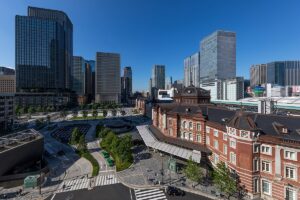Heijo Palace Ruins (Nara City, Nara Prefecture) — Overview (History, Features, and Attractions)
The Heijo Palace Ruins are the remains of the central part of Heijokyo, the capital city during the Nara period (710-794), and are now maintained as a vast historic park. Excavations and restorations have been carried out on the Daigokuden Hall, the former center of politics and rituals, as well as the Suzaku Gate and various other building remains, making it a place where you can get a real feel for what the capital was like during the Nara period. Excavations conducted since the Heisei era have revealed a vast amount of remains and artefacts, and in the 2000s restored buildings, a historical park, a museum and more were developed, and the site is also considered an important component of the World Heritage Site "Cultural Monuments of Ancient Nara."
Highlights
- Daigokuden (restored): A central building where important national ceremonies were held. Its majestic exterior makes it a popular photo spot.
- Suzakumon (restored): The Great Gate is located in front of the capital. The scenery in front of and behind the gate gives a sense of the scale of Heijo Palace.
- Excavated remains and a developed plaza: The rows of foundation stones and remains of buildings are preserved and displayed at ground level, and you can learn about their layout at the time through explanatory boards and models.
- Heijo Palace Site Museum (History Museum): Exhibits include excavated items, restored models, and excavation scenes. The origins of the ruins and the results of the investigation are presented in an easy-to-understand manner.
- Seasonal flowers and a wide lawn: Cherry blossoms bloom in spring, and cosmos bloom in autumn. You can enjoy picnics and photography in the spacious area.
- Events and nighttime illuminations: There may be special openings of restored buildings, traditional events, anniversary events, and illumination events (please check the dates).
Access (nearest station, transportation, etc.)
- From JR Nara Station: Approximately 20-25 minutes on foot, or 5-10 minutes by Nara Kotsu bus, rental bicycle, or taxi.
- From Kintetsu Nara Station: Approximately 25-30 minutes on foot, or 10 minutes by Nara Kotsu bus or taxi.
- bus: You can get close to the area by taking the Nara City Tourist Circular Bus or the Nara Kotsu local bus (we recommend checking the timetable and route in advance).
- Bicycle/walk:It is about a 10-minute bike ride from the center of Nara city. The site is large, so we recommend wearing comfortable walking shoes.
- car: Paid parking is available in the surrounding area. However, it can get crowded during the tourist season, so it is more convenient to use public transportation.
Estimated stay (estimated time required)
- Tour of the main attractions (Suzaku Gate, Daigokuden Hall, and Museum): 1-2 hours
- Leisurely stroll, photography, and picnic: 2-4 hours
- If you are visiting other historical sites in the area, such as Todaiji Temple and Kasuga Taisha Shrine: Half a day to a full day
Nearby spots
- Nara Park and Todaiji Temple (Great Buddha Hall) — A representative spot of the ancient capital of Nara, accessible by car or bus.
- Kasuga Taisha Shrine - An ancient shrine where you can feel nature and history.
- Naramachi - A strolling area lined with traditional streetscapes and shops renovated from traditional houses.
- Yakushiji Temple and Toshodaiji Temple — A group of ancient temples in the western part of Nara City, which can be visited together with historical sites related to Heijokyo.
- Nara National Museum — Houses and exhibits masterpieces of Buddhist art.
Things to be aware of (crowds, manners, seasonal precautions, etc.)
- congestion: The area is crowded during cherry blossom season, Golden Week, the autumn tourist season, and consecutive holidays. Parking lots and buses tend to be crowded, so please allow yourself plenty of time.
- Conservation Manners: The ruins are valuable cultural assets. Please be mindful of the site, such as not entering restricted areas, not touching the remains, and following the posted notices.
- photo shoot: Generally, photography is permitted outdoors, but there may be restrictions on photography of exhibits or during special public viewings. Please check the information board to see if photography is permitted inside the museum.
- What to wear and what to bring: The grounds are large and you will be walking a lot, so wear comfortable shoes. In summer, the sun is strong and there are few places to block it, so bring a hat and hydrate. In winter, the wind is strong so be sure to take precautions against the cold.
- Smoking and trash: Please observe good manners even outdoors, smoke in designated areas, and take your trash home or dispose of it in the designated area.
- Use of drones, etc.: Drone flying may be prohibited or restricted in some areas due to cultural property protection and safety concerns. Please check in advance.
- Check facility information: The museum's opening days, exhibits, special exhibitions, and events may vary. Please check the official website or tourist information for the latest information before visiting.
The Heijo Palace ruins are a vast place where you can feel the history. You can imagine the capital of the Nara period from both the restored buildings and the excavated remains, and you can enjoy a deeper historical stroll by visiting the surrounding ancient shrines and temples.


